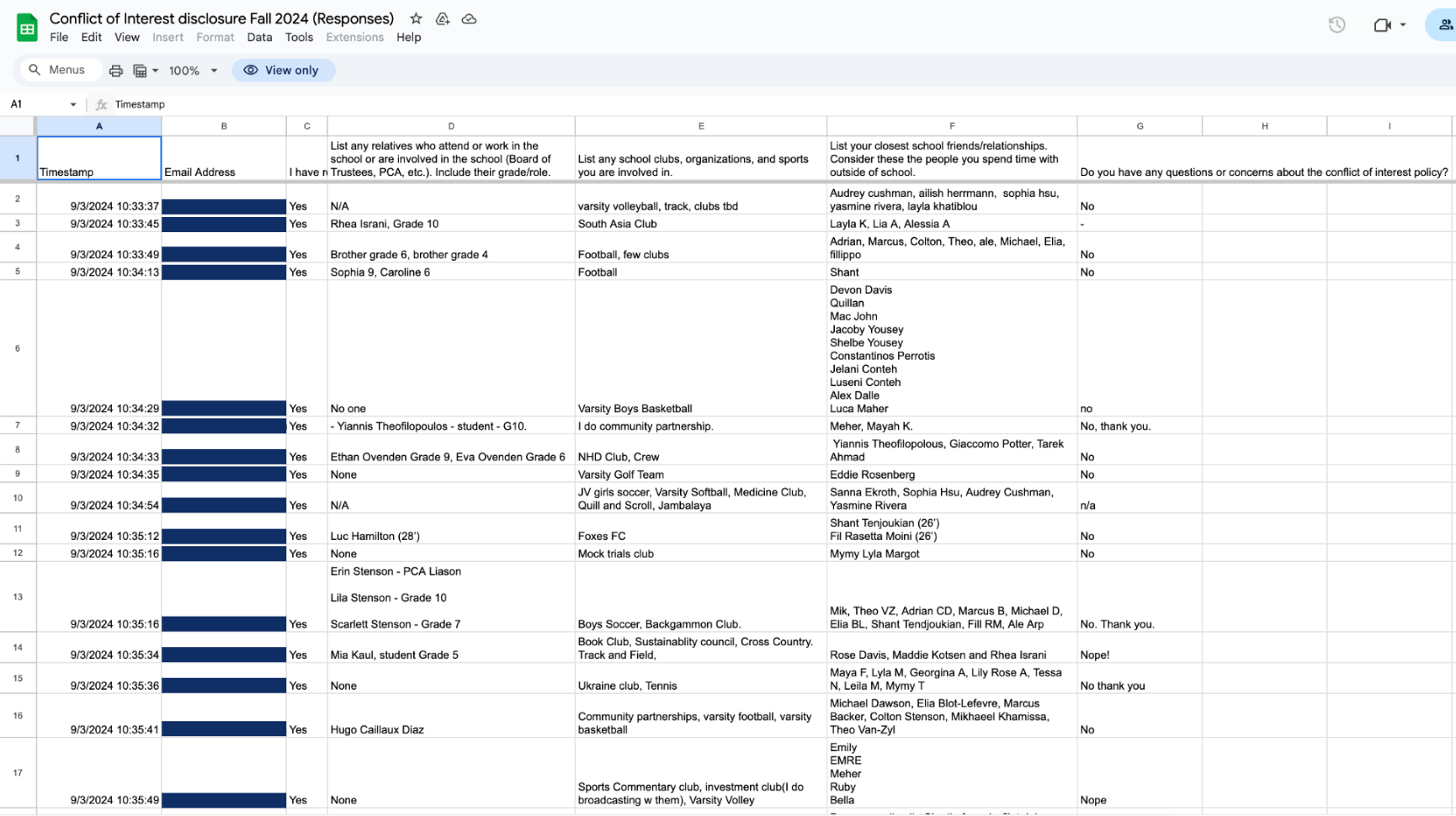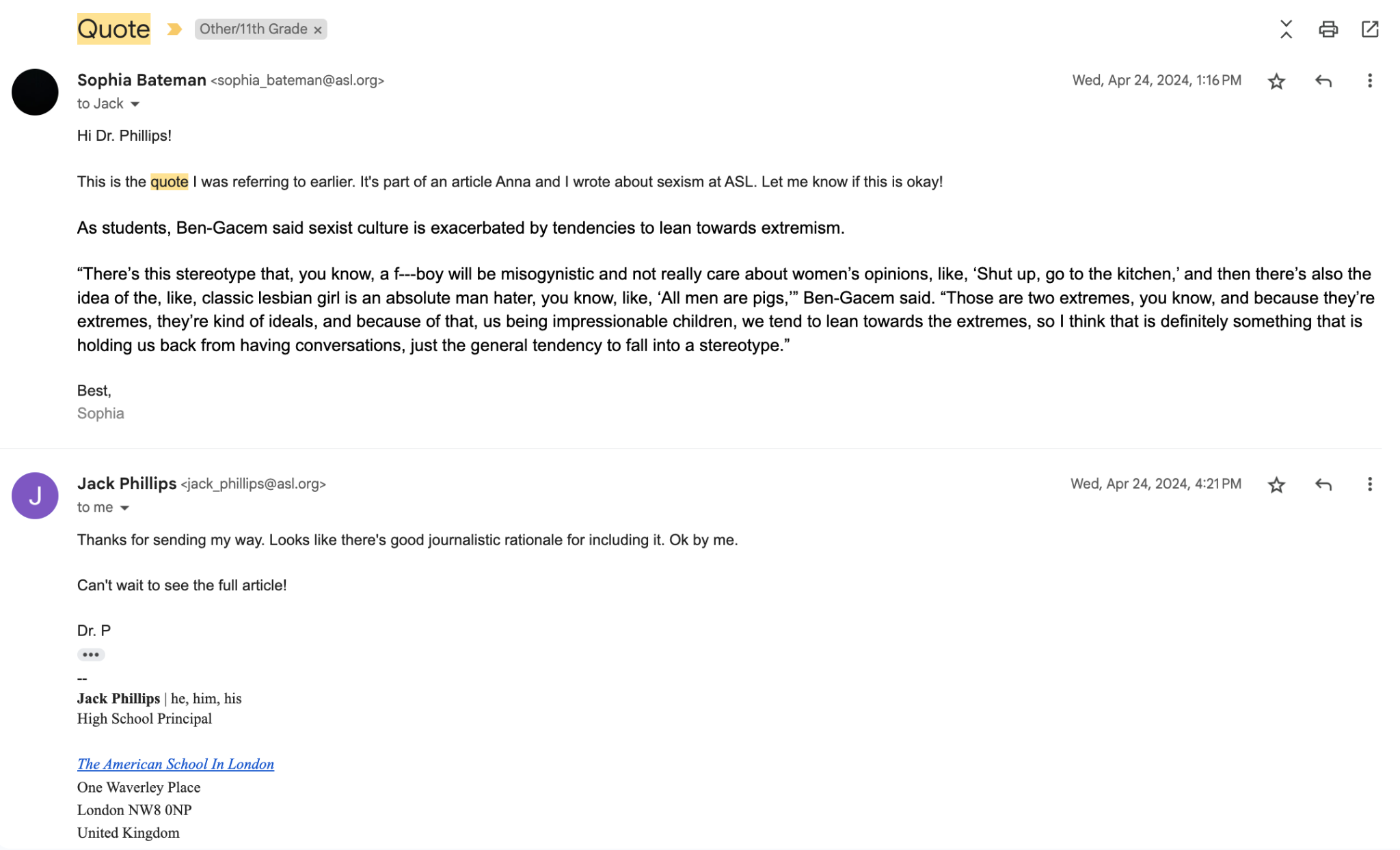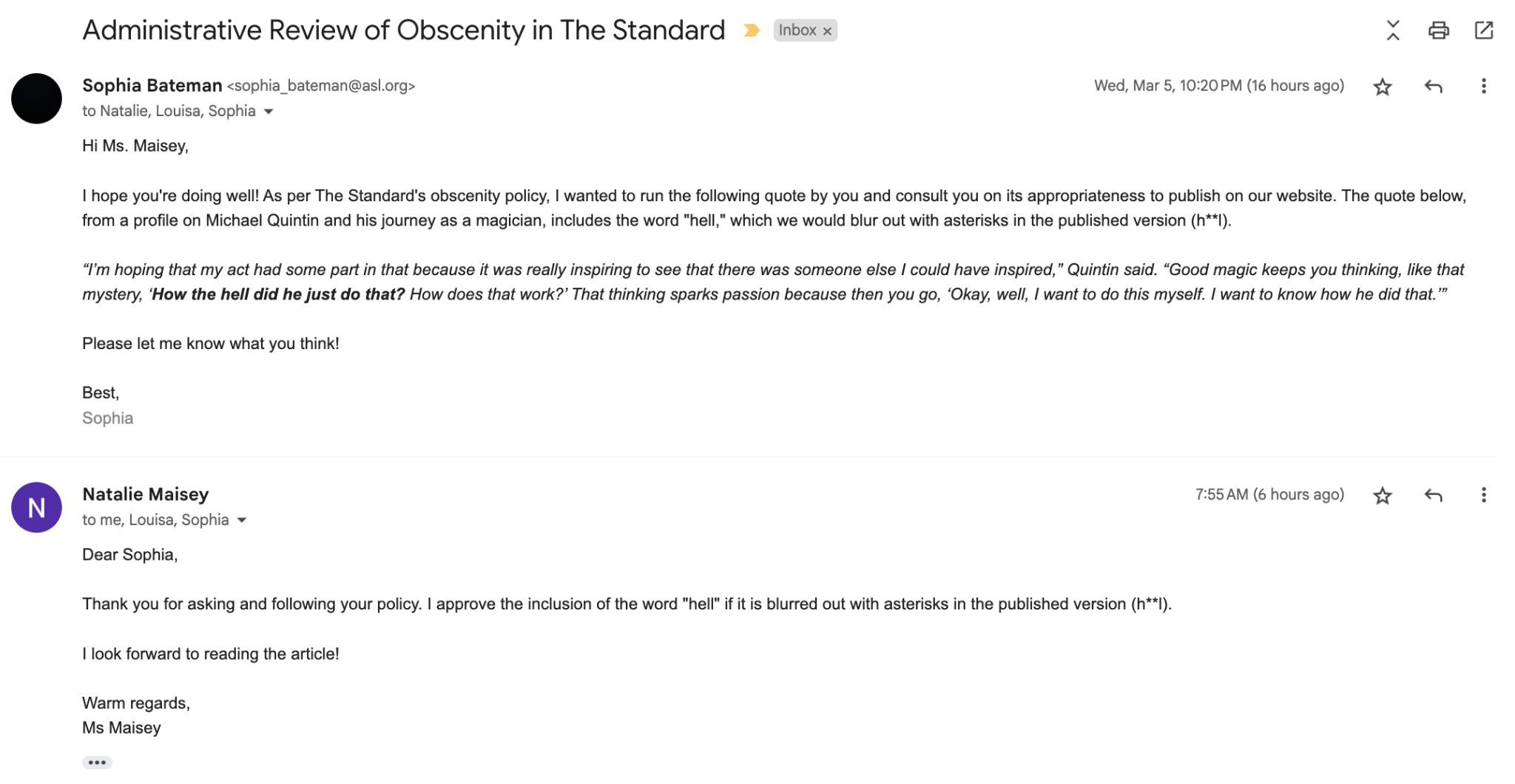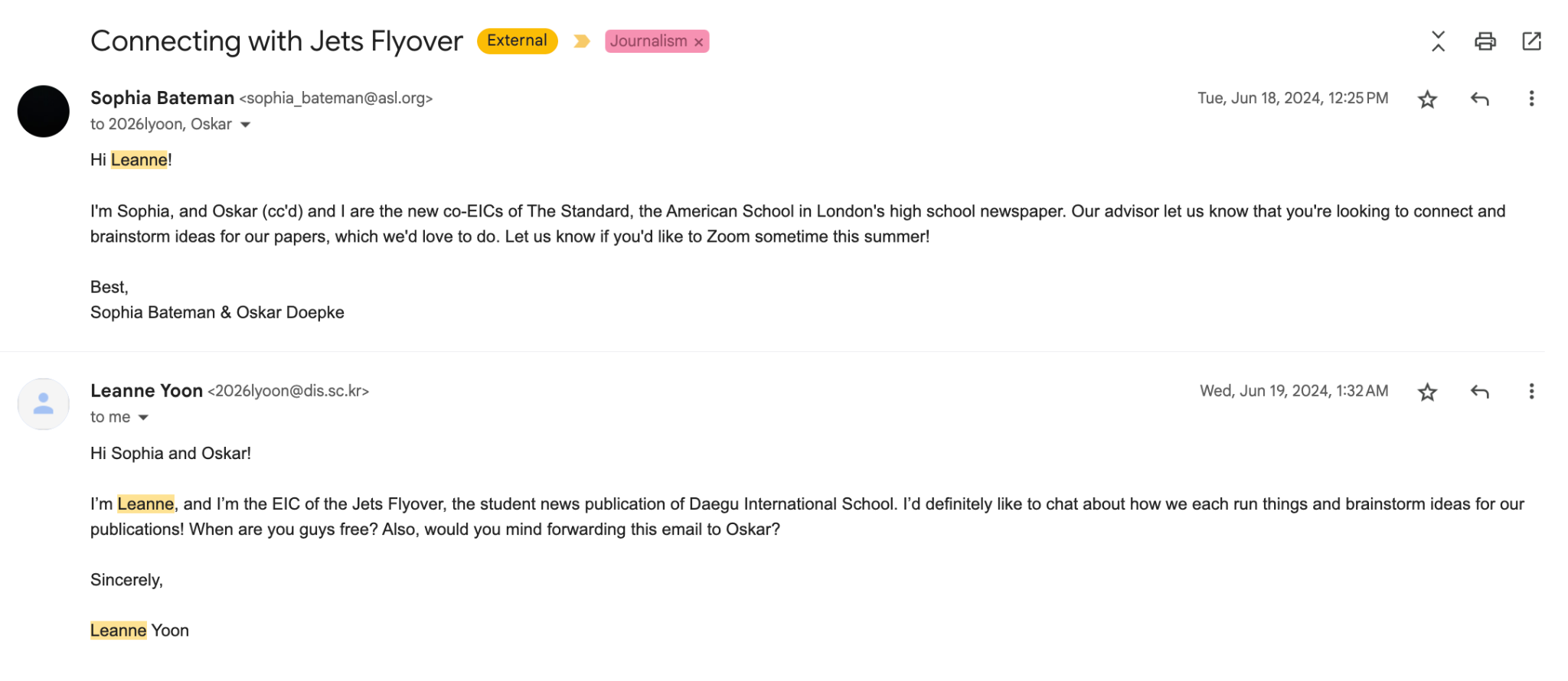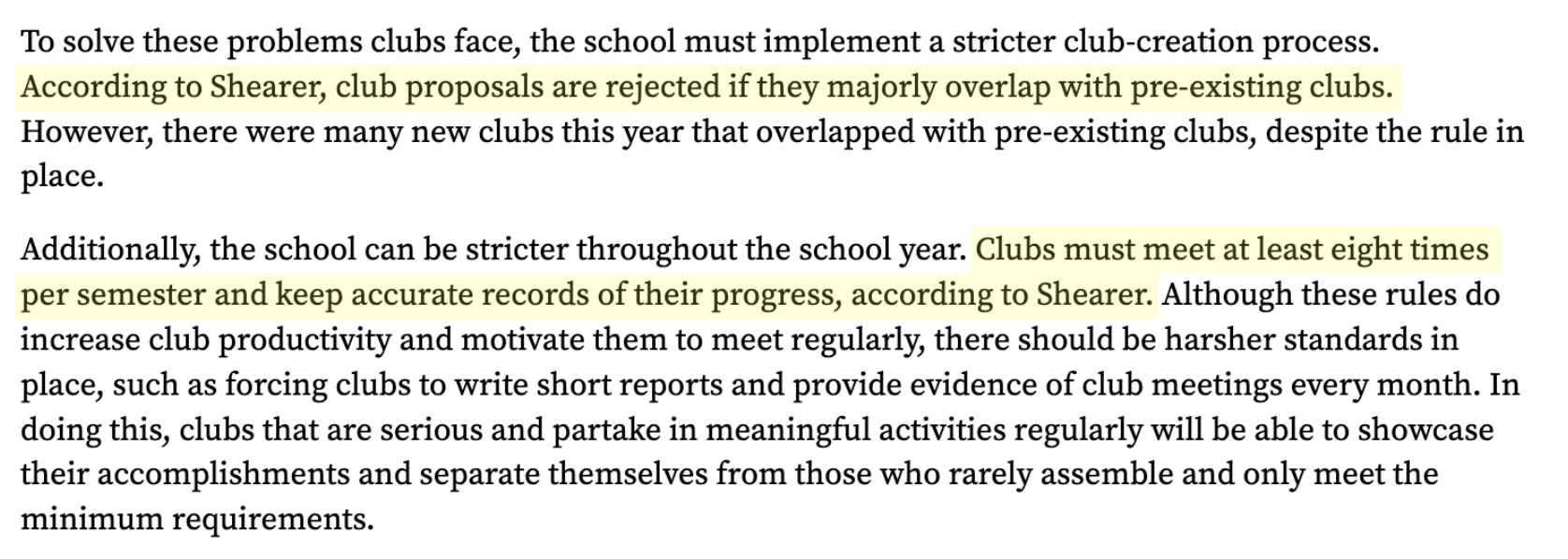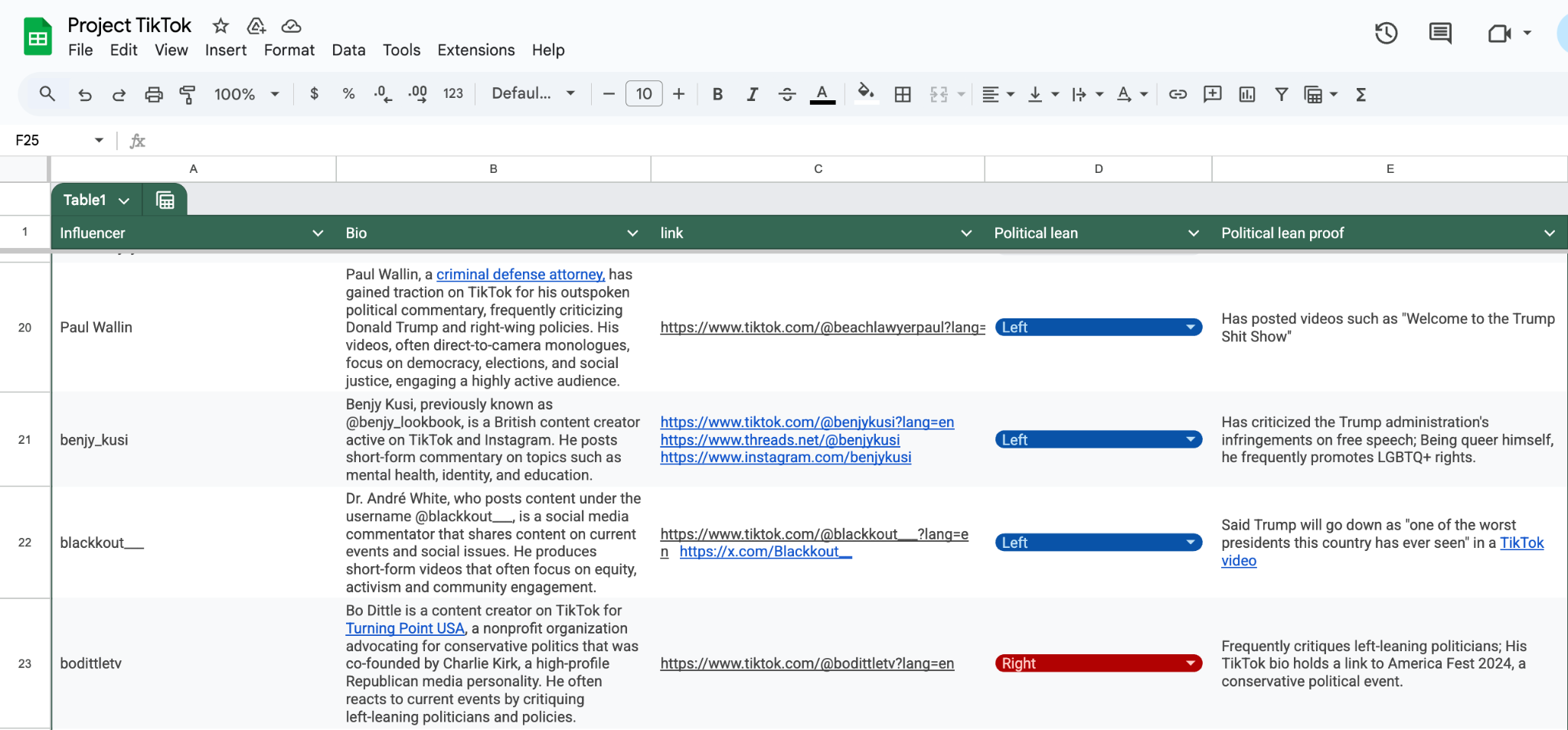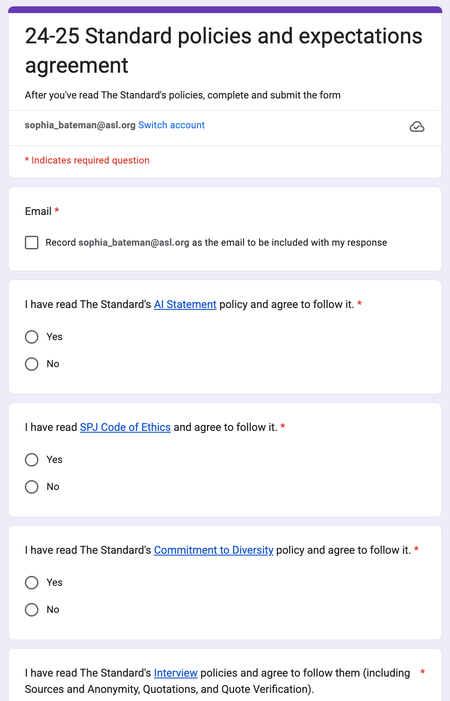

I present to my high school alongside my Deputy Editor-in-Chief: Online on misinformation and fact-checking Oct. 24, 2024.
In September 2023, our Interim High School Principal signed the Affirmation of Student Free Expression Rights, which solidified the ethical framework that guides our coverage and protects our voice as student journalists. This commitment to free expression not only underpins our publication's approach to law, ethics and news literacy but also empowers us to uphold transparency and integrity in every story we report. Given that ASL is located outside the U.S. and doesn’t benefit from First Amendment protections, this affirmation is our foundational safeguard. Click the image below to view our publication's coverage of the signing and learn more about the agreement.
We published the agreement on our website to increase transparency with our readers. This ensures they can easily review the ethical standards that guide our work, which, in turn, reinforces the trust we seek to create with every story. View that here.
In April 2024 at the Spring NHSJC, ASL was honored as one of just 28 schools to receive the First Amendment Press Freedom Award — the first time an international school has ever earned this distinction. Despite operating outside of the U.S. and thus not being protected by the First Amendment, we continue to champion its core values of free expression and open debate.
By December 2024, ASL had advanced to the second round for this year’s FAPFA, and I had the opportunity to complete part of the application. The process of filling out the form reinforced what I already knew: our publication remains a truly uncensored forum for public discourse, free from any administrative oversight or prior review.
We were named one of only 16 schools to receive the 2025 FAPFA — once again the only international school to ever receive this award — Feb. 27. Click on the email below to read the JEA's press release.
This summer, my journalism adviser tasked the managing team — the Editor-in-Chief: Print, Deputy Editor-in-Chief: Print, Deputy Editor-in-Chief: Online and I — with updating the documents in our staff manual, most of which hadn't been touched in over four years. Our staff manual, seen below, is home to several key documents that guide the way The Standard operates. The three other members of the managing team and I called several times over the summer to meticulously edit each document, ensuring they would all be ready for the new school year.
Before (last revised September 2021):
After:
In the updated version, we added a table of contents at the top to improve navigation and accessibility, especially given the document’s length. We also revised outdated sections, such as the mission statement and editorial board, to reflect current staff roles and responsibilities.
Before (last revised September 2021):
After:
In the updated version, we removed irrelevant sections such as the story cycle and beat system, which no longer reflect our current workflow. We also revised each section for clarity, consistency and improved wording. I personally rewrote the Deaths, Suicides and Obituaries section, drawing inspiration from policies used by other publications.
Before (last revised May 2020):
After:
Over my past three years on staff, I noticed frequent inconsistencies in how we referred to titles and roles — for example, whether to capitalize a teacher’s title, a coach’s position, or a department head’s role. To address this, I updated our style guide with clear standards for these common issues, ensuring consistency across our publication going into the school year. This update has made a significant difference in streamlining our editing process and maintaining professionalism in our writing.
Once school resumed, we presented the updated manual to our staff, and I sent out a Google Form highlighting essential policies from the Policies and Expectations document that everyone was required to complete Sept. 11, 2024. By ensuring every staff member was informed and agreed to these standards, we strengthened our ability to hold reporters accountable and maintain the high journalistic standards of The Standard. It also unified our team with a refreshed understanding of how The Standard operates.

I then individually published each of the policies from the Policies and Expectations document on our website to increase transparency with our readers. These can be viewed here.
Our updated staff manual now lives on our Standard Everything Guide, which is our staff's go to document holding a variety of helpful resources. It is highlighted in orange.
The Standard's Conflict of Interest policy, which is published on our website and lives separately from our Policies and Expectations document, serves to ensure that our coverage remains fair, accurate, and free of bias — cornerstones of the SPJ's Code of Ethics, which we follow (see next section).

To complement this policy, we required all staff members to fill out a Google Form disclosing their closest relationships within the school at the beginning of the year — similar to the Google Form about our Policies and Expectations document. This extra step added an important layer of accountability, helping us track potential conflicts — especially since our staff is large, and it's impossible to know everyone's personal relationships. By proactively gathering this information, we create a more transparent and ethical environment where all potential conflicts are addressed, ensuring the integrity of our reporting.
The Standard does not verify quotes for every article, and we are also not under any policy of prior review. However, when a source requests verification, we send them both the exact quote and its contextual introduction so they can confirm their words are represented correctly. If they feel something is off, it opens the door for a conversation between the reporter and the source, but it isn’t mandatory that they alter the final text. Below is a copy of our full quote verification policy, which I helped update this summer.
This approach upholds our commitment to integrity while giving sources the opportunity to verify their contribution, and our full quote verification policy is available on our website for transparency.
When writing my sexism story, one of my sources reached out to verify his quotes. Below is the email I sent him, along with his reply.

The following document displays each quote and any changes that may have been made based on his feedback.
The Standard also follows a policy of consulting our High School administration before publishing any content that contains profanity. I revised this policy over the summer, as it is included in our Policies and Expectations document. Although this process is rarely needed, I applied it last year when a quote in my sexism story contained profanity, as shown below.
More recently, I reached out to the Interim High School Principal about the inclusion of the word "hell" in an article I edited that was going to be published on The Standard's website. Below is a screenshot of our emails to each other.
Following copyright law is essential in journalism because it ensures transparency in our reporting. It would be unfair (and unlawful) for us to pass off images as our own — and it would risk us having our content taken down. In our revision of The Standard Stylebook this summer, I wrote the section for how we credit images from free-use platforms like Flickr and Wikimedia Commons.
In my editing, I enforce this rule to ensure both credibility and consistency. Below is an example of my communication with a reporter who attempted to use a copyrighted image for his story, as well as the crediting policy I wrote and a photo credit on our website.

This past summer at the Medill-Northwestern Journalism Institute, I participated in several sessions on law and ethics. My notes from sessions like "Journalistic and Academic Integrity," "Law of Libel," and "The Impact and Implications of GenAI on Journalism" provided valuable insights that I applied while revising our staff manual. These experiences deepened my understanding of ethical and legal issues in journalism. Below are the notes I took from these classes.
Over the summer, I reached out to the EIC of another international school newspaper in hopes of expanding our network and learning more about how they operate.
After our Zoom in August, we exchanged some text messages where I shared answers to some of the EIC's questions relating to law and ethics. On the left are Leanne's (the EIC) questions, and on the right are my replies — organized by row, with the related parts highlighted.
During our revision of our staff manual, we made the decision to abide by the Society of Professional Journalists Code of Ethics rather than creating our own from scratch or updating an outdated version. This approach allowed us to benefit from a well-established framework that embodies decades of journalistic best practices, ensuring our guidelines are both comprehensive and widely recognized. By leveraging these industry standards, we avoided reinventing the wheel and provided our staff with clear, trusted regulations. The SPJ's four principles — seek truth and report it, minimize harm, act independently and be accountable and transparent — now guide our reporting. Our decision to utilize this code is published on our website and can be viewed here.
Responsible sourcing lies at the heart of ethical journalism — it’s how we ensure every story we publish is grounded in verified information. While editing a piece on our school's switch from Schoology to Teamie, I noticed key details lacked confirmation from an authority source. Most students and faculty members were unhappy with the change, and that was certainly reflected in the article's quotes, but I knew we had to include comment from someone involved in the decision to report responsibly. So, I asked the reporters to circle back and secure input from someone with direct knowledge.
Below, you can see versions of the story before and after the reporters included the authority source (highlighted in light green) following my edits.
Ensuring the right of reply is essential, especially when a story names a specific individual rather than a vague entity like the High School administration. In a story I edited this year, a reporter criticized the Clubs Coordinator by name, arguing that the club creation process needed to be stricter, without reaching out for her perspective. The DEIC: Online and I advised him to contact her for a comment, and her input was subsequently included in the final version. This not only enriched the story but also upheld our commitment to fairness and ethical reporting. See a portion of the published version below, with her comments highlighted.
Anonymous sourcing in journalism requires a careful balance between protecting vulnerable individuals and maintaining the transparency and credibility of a story. When dealing with anonymous sources, I am always acutely aware of how each additional one can weaken a story’s credibility. It’s essential to reserve anonymity for situations where revealing a source’s identity could jeopardize their safety or privacy, while still ensuring that the information provided is verified and significant.
When writing my story on the prevalence of sexism at ASL, I included a source who only agreed to be interviewed on the condition that their identity remain confidential. On The Standard, we protect anonymous sources by assigning pseudonyms and clearly noting their anonymity with a disclaimer and an asterisk, as shown below. To further safeguard the source, I verified that the chosen pseudonym did not match anyone in our school directory, reducing the likelihood of any unintended identification.

My experience using an anonymous source has helped me greatly in leading our staff this year. Below are examples of me guiding other reporters' uses of anonymity. Click on each image to learn more about the situation.
Source diversity is a cornerstone of ethical journalism because it provides a fuller, more balanced picture of any issue by incorporating multiple viewpoints. In my writing, I've made a deliberate effort to include voices from various backgrounds, grades and genders. This can be seen in the artifacts I've included in the Commitment to Diversity section.
One example I will highlight is while writing my sexism story, I recognized the importance of incorporating a broad range of voices from our school community. So, I made a deliberate effort to reach out to students and faculty across all four grades — even when it was initially challenging to find an underclassman willing to speak openly about the issue. This commitment to source diversity enriched the narrative and ensured that our reporting reflected multiple perspectives. In the image below, you can see the amount of sources (and underclassmen) we reached out to, as well as our source diversity tracker mid-way through completing interviews.

Aside from my own reporting, I have also mentored reporters on the importance of source diversity. Earlier this year, I edited a story about the impact of the Middle East conflict on our school community. On my first read-through, I noticed the reporter had only interviewed one male teacher and two senior boys. I suggested he broaden the range of voices by including a wider mix of community members to ensure the story was well-rounded. Below I highlighted a key part of my feedback.
The Standard has also taken several new steps this year to ensure source diversity. This year, we began utilizing an automated source tracking system that was designed to streamline and advance the efficiency of our source tracking process. Once a reporter publishes a story — whether in print, online or on social media — they fill out a form where they input the sources used in their story. This is then updated on the spreadsheet, where we keep track of how many times each source has been interviewed.
Learn more about The Standard's diversity, equity and inclusion efforts — including a more in-depth look at source diversity — in the Commitment to Diversity section.
In the U.K., recording someone without their consent isn’t automatically illegal, but it largely depends on the context. In public spaces, where people have a limited expectation of privacy, recording is generally allowed. However, in private settings or in situations where individuals have a reasonable expectation of privacy, recording without consent could potentially breach privacy laws or be considered harassment. Therefore, I teach all reporters to ask for their interviewee's consent before recording.
Below is a screenshot of one of my interview preparation notes — I always write a reminder at the top of my questions list to make sure I don't forget to ask for permission.

In the rare case that an interviewee doesn't give permission for me to record their interview, I take substantial notes in my reporter's notebook and only publish quotes I am completely certain are accurate. An example of my notes is included below from an interview I conducted with the CEO of Depop, Kruti Patel Goyal.

Furthermore, to uphold our ethical standards, I more strictly enforced our policy of requiring reporters to include interview transcripts in their FLOW documents this year. We do this for two main reasons: (1) verifying quote accuracy to prevent fabrication and (2) assisting reporters in choosing stronger, more relevant quotes during the editing process.
In addition, in one of our first Standard Club meetings, I presented this slideshow to club members to give them a well-rounded introduction to conducting interviews, including asking for permission to record. Read more about the club in the Commitment to Diversity section and Editing, Leadership and Team Building section.
Fact-checking is fundamental to our credibility, ensuring every detail we publish is accurate and reliable. I meticulously verify every piece of information — from verifying hyperlinks to confirming the correct spelling of names. For instance, in a recent story, I caught an error where an interviewee’s name was misspelled and corrected it. I then explained the importance of fact-checking details like this to the reporter and referred her to resources to utilize in future stories.
While descriptive details can enrich a story, they can also inadvertently reinforce stereotypes if not handled thoughtfully. While studying at the Medill-Northwestern Journalism Institute, I learned to question whether including factors like race, ethnicity or gender in a story is truly necessary. One memorable exercise asked us to consider a hypothetical hostage situation with a Black perpetrator, prompting us to consider: Is this detail necessary? Would we include it if the perpetrator were white?
I applied this lesson when editing an opinion piece on women’s safety in major cities. The writer’s description of a “likely intoxicated man in his 30s — his jeans sagging and hair disheveled” risked contributing to biased perceptions without adding any necessary context. Removing it aligned with our commitment to ethical reporting and minimized the chance of perpetuating prejudice. The image below shows the comment I left the reporter explaining my edit.
Just as we need to credit our images, it's equally important for us to attribute information we reference in stories to the correct sources. By properly citing each reference, we ensure accuracy and uphold journalistic integrity. Below is a comment I left while editing a story on the possibility of a third world war breaking out, with the before and after of the statement I edited.
Original:
"Rather than launching massive troop and artillery deployments, nations now prefer to use smaller-scale coordinated tactics, which are less likely to trigger a defensive response from numerous other world powers."
After my edit:
"Rather than launching massive troop and artillery deployments, nations now prefer to use smaller-scale coordinated tactics, as seen in Ukraine’s shift to small-scale assaults and the U.S. Marine Corps’ distributed operations strategy stated by The Modern War Institute."
Similarly, in our multimedia content such as podcasts, videos and Geniallys, we provide proper attribution for music and other resources, which upholds copyright laws. This year, I introduced a requirement for reporters to include credits for infographics, such as those made on Genially, to ensure all aspects of our content are sufficiently credited. Below are some examples.

In my role as EIC: Online, I'm responsible for approving comments on our website. Comment sections serve as an essential platform for free expression and community engagement, so it’s crucial for me to consider every comment thoughtfully.
In one comment, a reader disagreed with an opinion piece. Although their tone was critical, it posed no threat and didn’t violate our ethical guidelines, so I approved it in the spirit of open dialogue.
In contrast, we often receive spam submissions that are irrelevant and self-promotional, which I do not approve because they undermine constructive conversation and the overall integrity of our forum.
In our commitment to journalistic ethics, proper categorization is essential. By clearly labeling each piece as news, opinions, features, arts or sports, we ensure that our audience understands the nature of the content they’re engaging with. This practice prevents opinion pieces, even those enriched with important background details, from being mistaken for straight news, thereby preserving our credibility and fostering informed readership.
This year, I've refined our content categorization to provide clearer guidance for our readers. Now, opinion stories can be subcategorized as editorials or guest submissions, and art stories can be subcategorized as reviews. We also have a multimedia section that houses almost every story on our website, as every story must include some form of interactivity. Below are a few examples of categorization.
Although our satire edition, The Slanderd, may not be our most professional work, its reintroduction last year quickly made it one of our most anticipated and beloved editions. Since it was our first time producing a satire issue in several years, we faced ethical hurdles in managing content and editorial decisions. To address those challenges this year, I created a process and content guidelines document for our staff outlining how to ethically handle source-based stories in satire while maintaining both journalistic integrity and creative freedom.
For last year's satire edition, I co-wrote a story with the now Editor-in-Chief: Print. Once we finalized the draft, we made sure to share the story with every quoted source and secured their approval before publication.
Last June, my journalism adviser sent all Standard staff members an email about a new paid journalism opportunity for U.S. citizens. Seeing as I fit the criteria, I thought, "Why not?" Months after receiving my acceptance email in July, I can say with certainty that I am so glad I applied. MediaWise's TFCN has granted me an opportunity to explore fact-checking beyond what I had previously experienced at internships, and as the first international student member, I'm proud to be a part of it.
Below are just four of the fact checks I've created during my time on the network. Click on each image to view the Instagram reel. Each fact check was also published on Facebook, X and TikTok, amassing over 16,500 views total.
Below, I chronicled the process of creating one of my fact-checks — specifically, the LA wildfires one.
First, I came across the reel while scrolling on Instagram. I did some preliminary research and then sent in a pitch on our MediaWise Slack channel. I got a response from MediaWise's Youth Programming Manager, Kathleen Tobin, on the same day and started working right away.
Next, I wrote the script for my video and addressed edits on it from both Ms. Tobin and MediaWise's director, Alex Mahadevan. Below is a copy of the final script.
After receiving approval of the script the next day, I recorded and edited the fact-check using CapCut. Once I finished, I sent it back to our Slack channel, where the video was edited. After addressing those edits, I sent the final version back to the Slack channel, and it was then published on MediaWise's social media platforms.
I have also taken part in network-wide videos in celebration of Student Press Freedom Day, which was in collaboration with the Student Press Law Center, and Media Literacy Week. Click on the images below to watch.
When our Interim High School Principal invited the Editor-in-Chief: Print and me to lead two assemblies for our entire high school — one for Grades 9 and 10 and the other for Grades 11 and 12 — I was initially cautious about addressing such a large audience. However, it turned into a valuable opportunity to align our journalistic values with the larger school community. The experience enhanced my confidence and played a role in boosting news literacy among my peers in light of the upcoming U.S. election. I ended up leading one of the assemblies alongside the EIC: Print and the other alongside the DEIC: Online. View the presentation my EIC: Print and I created together below.
I even presented one of my MediaWise fact-checks during both assemblies. Below is a short clip of me talking about MediaWise and the work I do with them before playing the video.
Following our assembly, I received a lot of positive feedback from students and faculty alike. Below is an email I received from one of the health teachers after leading the first assembly.
The ASL Speakers Series is a tradition at my school featuring distinguished speakers who deliver 45-minute talks followed by a half-hour Q&A — a practice dating back to the 2001-02 academic year. I was honored to be invited to co-lead a panel titled "The Impact of Misinformation on Global Elections and Democracy," which brought together Professor Chris Anderson from the London School of Economics, Derya Matras from Meta and David Rhodes from Sky News Group. 150 community members attended the event.
This panel was especially important in educating our school community on news literacy, as it delved into the profound effects of misinformation on democratic processes. I was particularly interested by Derya Matras' insights into Meta's fact-checking policies (This was, of course, before Meta actually announced the end of their third-party fact-checking program!). Click the image below to read more about the event.
We met several times in advance to carefully plan our questions, ensuring it would lead to an engaging conversation on the day and touch on three key areas — technology, media and political science — by involving each of the panelists. Below is the document of finalized questions I used on the day.
Click the video below to see a short clip of me asking a question about journalistic objectivity on the panel.
At this year's Aequitas Day — a day organized by the Social Justice Council that lets students lead workshops on social justice topics of their choice — I co-led a session titled “Politics, Propaganda, and Polarization: The Weaponization of the Mainstream Media” alongside the EIC: Print. Our workshop delved into how political agendas and media narratives intersect, using case studies to show how misinformation shapes public discourse. We aimed to equip our peers with practical insights to better navigate today's complex media environment. Below is the official workshop description that was shared with the high school, as well as a picture of me presenting — Click on each one to see a larger view.
Below is the presentation we created and presented together.
This year, I’m pursuing an independent study with my journalism adviser titled “Who Really Won? A Comparative Analysis of Local and International Election Coverage in 2024.” At my school, independent studies are available to students who have exhausted departmental curriculum offerings in the subject they wish to pursue and demonstrated a strong capacity for independent work.
Below is the proposal I submitted to my High School administration, which was ultimately approved. My goal is to publish the final article to help people understand the underlying factors that shape news coverage and underscore the importance of news literacy.
Agência Lupa is arguably the largest fact-checking organization in Brazil. After cold-emailing a Duke professor about fact-checking opportunities at his lab, he put me in contact with the organization, which led to a five month remote internship. I can confidently say this experience was one of the most foundational stepping stones in my journalism career, as it kickstarted my interest in fact-checking and led me to the other amazing journalism opportunities I've been fortunate enough to participate in since. I cannot thank him enough.
During my time at Agência Lupa, I worked on a project to create a monitor that detected the spread of misinformation by Brazilian politicians. Specifically, I used my coding skills to write the algorithm that detected hate speech in YouTube videos.
As the internship was conducted entirely in Portuguese, the code below may be difficult to decipher. Click on each image to view a larger version of the picture, and use the side arrows to view all six images.

I started interning at Newsreel — an interactive news app startup aimed at increasing news literacy and combating news avoidance — after cold-emailing its founder exactly a year ago now. Newsreel's mission is to create an informed, engaged generation of young people through clear, concise news that empowers them to understand the world and contribute to meaningful conversations. The three key features of the app are a swipeable interactive carousel that delivers top stories of the day, timelines that show how key events unfold over time and quizzes that reinforce learning. The app is now piloting at universities across the U.S. and Canada, including Penn State, Colgate, Oberlin, Pace and Toronto Metropolitan University, among others.
Since starting as an intern, I've contributed to all three features as well as their social media, and I now get paid to write stories for the app twice a week. I aim to write in a clear, digestible way, ensuring all added multimedia contributes to readers' understanding of the story, thus increasing news literacy. Click on each image below to explore a few examples of my work — You'll be taken to a screen recording of me swiping through the story.
Another one of the app’s features that is currently in development is a news influencer database designed to help users research the social media accounts they come across online. This aligns with Pew Research Center's findings indicating that one in five Americans regularly get their news from influencers on social media, yet 42% of those individuals cannot name a single influencer they rely on. Each week, I contribute to expanding this database by researching and compiling background details on a range of influencers. Below is a portion of the spreadsheet I update.
